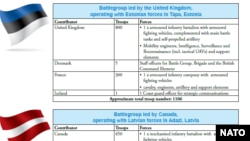NATO’s command structure includes two headquarters. One is aimed at ensuring the security of maritime routes between the U.S. and Europe, called MARCOM, and is a kind of analogue of what existed from 1952 to 2003. The Allied Land Command (LANDCOM) manages NATO’s readiness, military planning and, when activated, conducts land operations. However, the two major commands reorganized in 2012 represent “a leaner structure in an effort to address the current economic climate,” according to LANDCOM.
Recall that NATO as a military union was formed on April 4, 1949 – the day the founding agreement was signed by 12 countries in Washington. However, during its first two years, the organization did not have joint military structures. Those appeared only with the start of the Korean War (1950-1953). In the study “The Evolution of NATO's Command Structure, 1951-2009,” the former NATO chief historian, Gregory Pedlow, noted that when “the outbreak of the Korean War in June 1950 raised fears that Europe could be the next target of Communist aggression,” NATO “lacked the vital military element of command and control because there was neither a headquarters structure nor an overall commander.”
As a result, NATO created two headquarters – one for the Supreme Allied Commander Europe (SACEUR), in charge of NATO’s land, air and naval forces on the continent, the other for the Supreme Allied Commander Atlantic (SACLANT), responsible for ensuring the safety of sea lanes in the Atlantic and providing supplies to European allies.
SACLANT lasted 51 years -- from 1952 to 2003, two years after the September 11, 2001 terrorist attacks in the United States, when it was replaced by the Allied Command Transformation (ACT) located in Norfolk, Virginia (the old SACLANT headquarters location).
NATO Secretary General Jens Stoltenberg, following a meeting of NATO defense ministers on November 8, indicated the alliance is contemplating yet another change in its command structure.
“During the Cold War, NATO’s mission was to provide collective defense against the Soviet threat in Europe,” the Congressional Research Service noted in a report about a NATO summit in Prague in November 2002, during which a decision was taken to convert SACLANT into a new structure. “Some allies’ military structures remain geared for this threat, even though Russian conventional forces are weak and in disarray. The [President George W.] Bush Administration wishes to redefine the principal threats as terrorism and the proliferation of weapons of mass destruction. Administration officials believe that the United States is ‘at war’ today against the sources of these new threats and that the allies must be prepared to engage adversaries in North Africa, the Middle East, and Asia to ensure security.”
SACEUR did not disappear in 2003, but its structure and purpose had already changed fundamentally in 1999, and has been changed several times since. For example, SACEUR initially included three units. The “North” headquarters was located in Norway, along with three lower-level headquarters in northern Norway, southern Norway and Denmark, to repel a possible invasion of Norway and the Baltics. “Central” established its headquarters initially in France and then in the Netherlands, and two lower-level ground forces headquarters in northern and southern Germany. The “South” headquarters was located in Italy, and, along with lower-level ground forces headquarters in Italy and Turkey, was responsible for the security of allies in the Mediterranean.
In 1999, with the entry of Poland, the Czech Republic and Hungary into NATO, as well as the inclusion of Spain in the regional command structure, another reorganization of NATO’s command structure was carried out. The headquarters in Norway and the central command were abolished, and the “northern” command was handed over to the former headquarters of the Central sector in the Netherlands. In 2012, the combined headquarters of the ground forces in Europe were abolished and consolidated, and the mission of the headquarters in the Netherlands and Italy became the overall coordination of military units of the [NATO] member countries in the region. Meanwhile, the entire command of the ground forces was transferred to Turkey’s Izmir.
The U.S European Command reports that in 1962, more than 284,000 U.S. soldiers were stationed in Europe, while the number in 1991, at the end of the Cold War, was nearly 285,000. At the end of 2016, 64,400 U.S. soldiers were stationed in Europe.
NATO says it has “enhanced its presence in the eastern part of the Alliance” in the form of four “multinational battle groups” in Poland, Lithuania, Latvia and Estonia. The total number of soldiers in the four groups stands at about 4,760. That deployment was “a direct response to Russia’s aggressive actions in Ukraine,” Jens Stoltenberg said on October 9.
Directly on the borders of the Union state of Russia and Belarus, meaning in Baltic States and in Poland, the international contingent of troops from the NATO countries currently numbers 7,200. Another NATO brigade was recently established in Romania.









